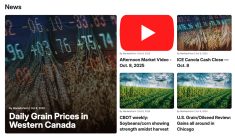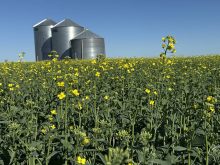Fed prices rise
Fed cattle prices climbed last week with steers averaging $3.30 per hundredweight higher and heifers $2.45 higher.
Once the suspect U.S. cow was confirmed not to have BSE, American prices rose $3 US, setting the tone for Canada, said Canfax. The tight supply of market-ready cattle also helped push packers to bid higher.
Canfax members reported about 18,500 head sold, down 20 percent from the week before.
Alberta prices Nov. 25 were steers $82-$85.30 per cwt., flat rail $138-$140.50 and heifers $80.75-$82.75, flat rail $138.25-$140.50.
Read Also

Huge Black Sea flax crop to provide stiff competition
Russia and Kazakhstan harvested huge flax crops and will be providing stiff competition in China and the EU.
Market-ready supplies are expected to remain tight so packers will need to bid aggressively this week.
Some plants are responding to the narrowing margin by killing fewer cattle. The kill two weeks ago was 73,000, down from the more normal 78,000, Canfax said.
Increasing supply and December holiday closures could pressure fed cattle prices lower.
Meat price up
Last week’s Canadian cutouts jumped considerably, matching the earlier large rise in U.S. cutouts.
The gain was $6 per cwt. on AAA and $4 on AA, Canfax said.
While Canadian prices jumped, U.S. cutouts edged lower, falling $1 US on Choice and barely steady on Select.
Product movement has been slow, a concern given the recent small kills. Tighter supplies in the pipeline usually move better.
Post-U.S. Thanksgiving sales and fill-in buying will be critical to maintain the recent cash cattle strength.
Wholesale beef carcass prices in Calgary rose $2-$5 Cdn in a range of $137-$145 per cwt.
Byproducts have lost ground partly due to the rising Canadian dollar, which largely affects hide values, but also lowers rendering values.
Light calf prices increase
Alberta auction market volumes fell slightly with about 57,000 head trading, but that is 50 percent more than a year ago, said Canfax.
Price averages for light calves rose as ranges narrowed because buyer confidence returned.
Steers 300-500 lb. rose $1.25 per cwt., while 300-400 lb. heifers climbed $4.50 and 400-500 lb. were $2 stronger.
Steers 500-700 lb. were 50 cents-$1.50 lower, 700-900 lb. remained steady, and 900 lb. and heavier were down 75 cents.
Heifers 500-600 lb. fell $1.25, 600-800 lb. were steady to 50 cents lower, and 800-900 lb. and heavier fell $1.50-$2.
D1, 2 cows held steady and butcher bulls were 50 cents higher.
Volumes will seasonally decline into December, Canfax said.
Averages on light cattle are expected to remain strong as confidence about the border increases.
Light volumes of heavier feeder cattle will continue to sell and prices should be supported in the near term by recent strength in fed cattle.
Stock bred cows were $250-$500 on poor quality, $500-$800 on medium and $800-$1,100 on excellent quality.
Bred heifers in southern Alberta were $800-$1,140 while in central and northern Alberta, bred heifer trade was $200-$600 on poor quality, $600-$800 on medium and $800-$1,175 on excellent quality.
Hog prices rise
Hog prices rose $1.02 US per cwt. Nov. 22-25. The average Iowa-Minnesota daily direct hog price (51-52 percent lean carcass converted to live weight) rose to $61.11 per cwt. from $60.09. The U.S. wholesale cut-out price for pork was similar to the previous week at $77.39 per cwt., said Manitoba Agriculture.
Quality Meat Packers in Ontario was closed due to a management-labour dispute that ended Nov 29.
Manitoba weanling pig prices rose, Manitoba Agriculture noted. The top spot prices for five kilogram and 23 kg weanlings were higher than the top contract prices. For the week ending Nov. 12, five kg spot prices topped at $55.11 Cdn per pig and 23 kg topped at $89.85 per pig.
Other livestock
Ontario Stockyards reported 2,064 sheep and lambs and 162 goats traded. All classes of lambs rose $8-$10 per cwt. and 37 new-crop lambs weighing an average of 64 lb. sold for more than $190 cwt.
Sheep prices were steady to stronger. Goats sold at higher prices.
















